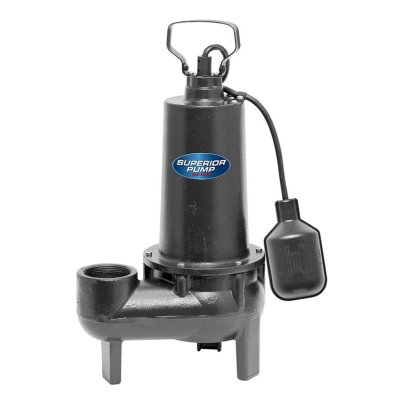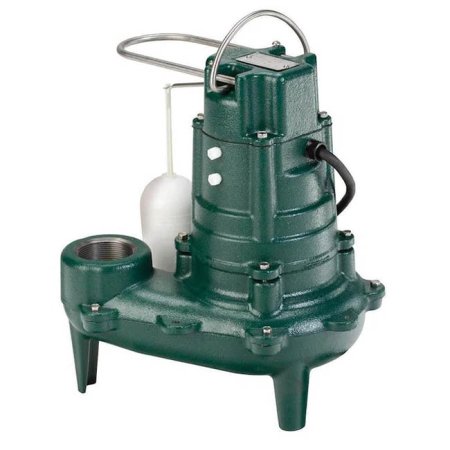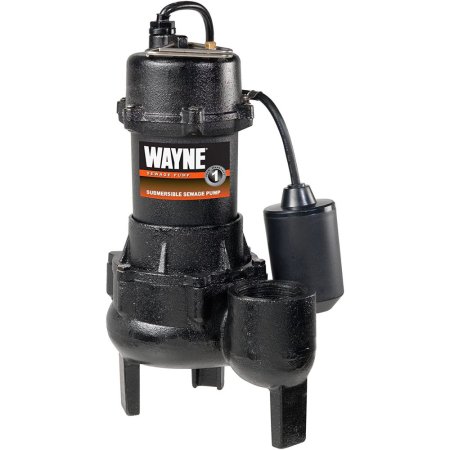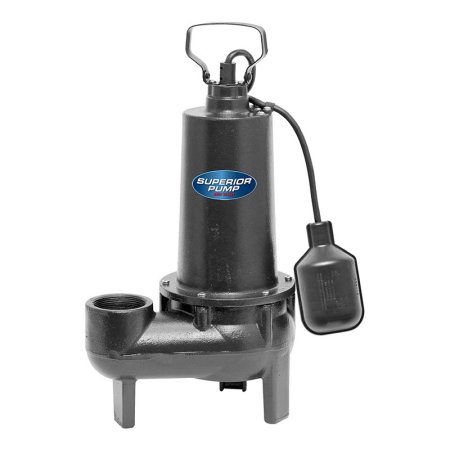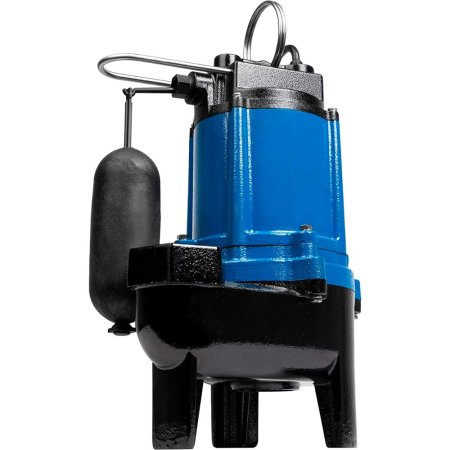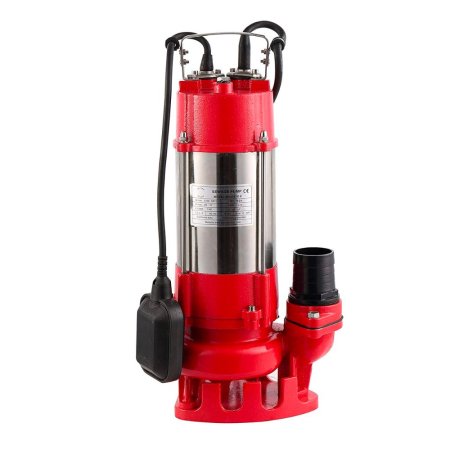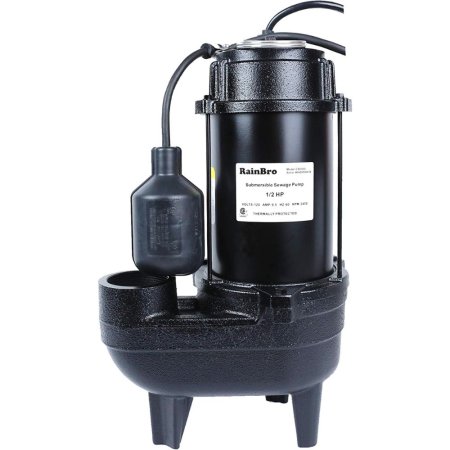
We may earn revenue from the products available on this page and participate in affiliate programs. Learn More ›
Homes outside of municipal sewer systems rely on septic systems for waste management. A septic system requires the use of a good sewage pump to move a home’s wastewater to the septic tank. Unlike effluent pumps or sump pumps, which move only water, sewage pumps can move wastewater with solids up to 2 inches in diameter. The best sewage pumps feature powerful ½-horsepower motors that can move up to 10,000 gallons of wastewater per hour to the septic tank or the main sewage drain. They feature durable cast-iron construction that can hold up in the murky environment of a wastewater basin.
With so many types of sewage ejector pumps on the market, determining which one is the right one can be challenging. This guide will go deep to determine what attributes are crucial to consider when shopping for a sewage pump while reviewing some of the top models on the market.
- BEST OVERALL: Zoeller 267-0001 Waste-Mate Sewage Pump
- RUNNER-UP: Wayne RPP50 Cast Iron Sewage Pump
- BEST BANG FOR THE BUCK: Superior Pump 1/2-Horsepower Cast Iron Sewage Pump
- UPGRADE PICK: Liberty Pumps LE51A LE50-Series Sewage Pump
- BEST DURABILITY: Little Giant LG-SEW50SA 1/2 HP Sewage Pump
- BEST HEAVY-DUTY: Hallmark Industries MA0387X-9 Sewage Pump
- ALSO CONSIDER: RainBro 1/2 HP Cast Iron Submersible Sewage Pump
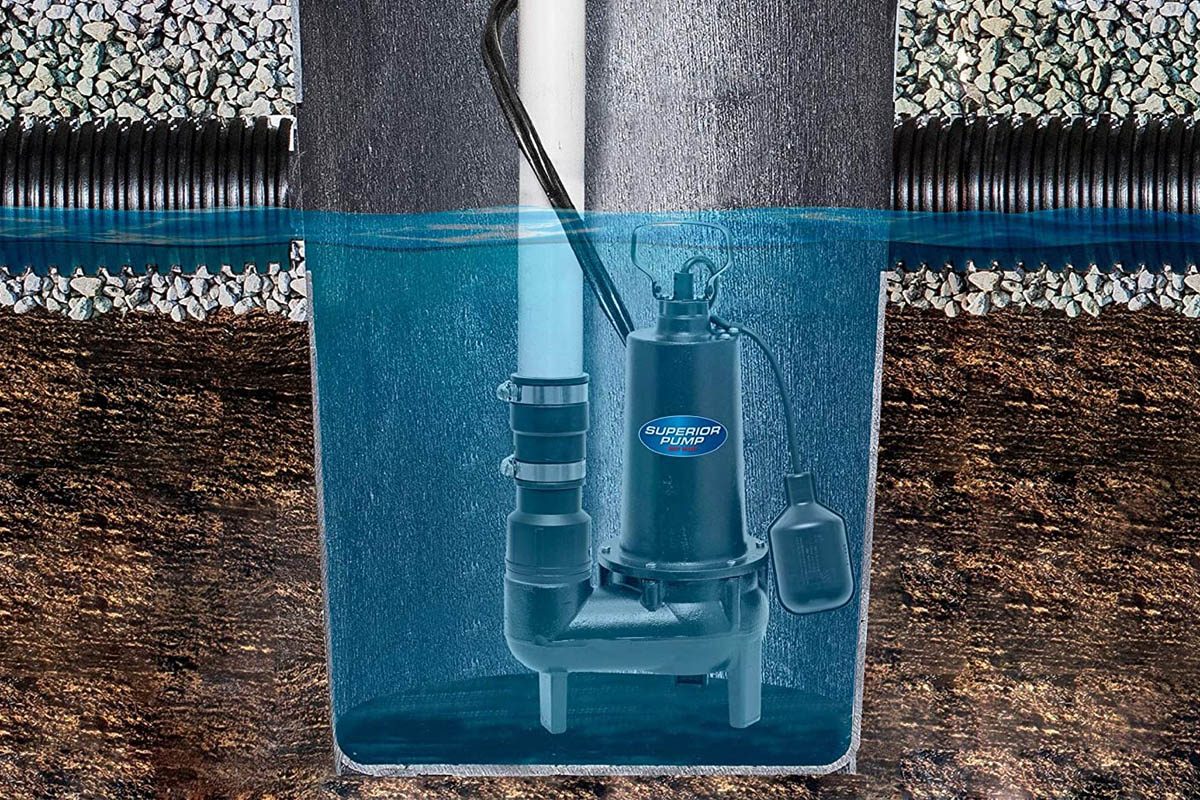
What to Consider When Choosing the Best Sewage Pump
While the number of gallons per hour your sewage pump can move is perhaps the most crucial factor to consider when shopping for a grinder pump, there are other critical factors, including the quality of the pump’s construction and the size of its motor. Ahead, learn more about these and other important attributes of a sewage pump.
Material
Sewage pumps spend their lives submerged in wastewater, so they need to be durable to endure. With that in mind, a sewage ejector pump is usually made out of either cast iron or thermoplastic. Cast-iron pumps are more expensive but are stronger and more durable and will therefore last longer than thermoplastic, which is less costly but will give out long before an iron pump.
The impeller, which is the part of the pump that moves the water, also needs to be durable to withstand the solid waste that passes through it. While many sewage pumps use impellers that consist of high-grade plastic, higher-end pumps feature impellers made from stronger materials, including aluminum and cast iron.
Some sewage pumps are also designed to easily swap out pieces that are likely to wear out before the motor does. This includes the float that operates the sewage pump’s automatic on/off switch and the power cord, both of which can eventually degrade.
Size and Weight
When shopping for a sewage ejector pump, it’s important to consider its size to determine if it will fit properly into a wastewater basin or septic pit. Most sewage pumps measure about 16 inches tall and 11 inches wide. The weight of these models varies depending on construction. High-end pumps with heavy-duty cast-iron housings can weigh up to 45 pounds, while models that feature cast-iron-and-plastic construction might weigh around 20 pounds.
It’s also crucial to consider the size of the pump’s input and output. A residential sewage ejector pump requires an input and output of at least 2 inches to handle solid waste up to 2 inches in diameter. Anything smaller will easily clog.
Horsepower
Horsepower determines just how much sewage a pump can handle daily. With this in mind, the larger the household, the more horsepower a sewage grinder pump needs to keep up with daily demand. A sewage pump with ½ horsepower is suitable for most homes, while large households with more than four people may require a sewage pump with 1 horsepower.
It’s important to remember that a sewage pump’s lifespan correlates to the number of hours it runs. More powerful sewage pumps need to run less often to move waste. This means they will have a longer lifespan than a weaker sewage pump that needs to work harder to handle a household’s needs. So, while a less powerful sewage pump may cost less up front, it won’t last as long as a more powerful sewage pump, negating the savings.
GPH
Gallons per hour (GPH) determines how much wastewater a sewage pump can move in an hour. Some manufacturers also use gallons per minute (GPM). A sewage pump’s GPH or GPM is determined by its horsepower and the elevation between the pump and the main sewage line or septic system the pump is pumping waste to. Similar to a sump pump, most sewage pumps will list their GPH with an elevation, commonly referred to as “head.” For example, a pump’s GPH might be 5 feet of head = 4,000. This means that the pump will move 4,000 gallons of water if the height difference between the pump and sewage line is 5 feet. The higher the elevation, the lower the GPH.
How much GPH a grinder pump can produce is determined by the horsepower of its motor and its design. As with horsepower, a less expensive pump with a lower GPH will ultimately not save money, as it will have to work longer to pump out sewage and will give out more quickly than a more powerful pump that does not have to work as hard.
Features
Most sewage pumps have features that protect the pump, and most come with thermal overload protection. This feature automatically shuts off the sewage grinder pump at a specific temperature to avoid overheating and damaging the motor. This feature is necessary to prevent the pump from burning out if clogged. It’s much easier and less expensive to clear a clog than it is to replace a pump with a burned-out motor.
Sewage pumps also have floats that turn the grinder pump on when the sewage reaches a certain level—typically around 15 inches—and off when the water level drops to about 6 inches.
Our Top Picks
The models below feature powerful motors, durable cast-iron construction, and high flow rates, making them some of the best models on the market. Any of the pumps below are worthy of serving as a home’s sewage-pump solution.
Best Overall
Zoeller 267-0001 Waste-Mate Sewage Pump
Pros
- Cast-iron construction; completely submersible
- Moves up to 128 gallons per minute
- Non-clogging impeller for solid objects
- Automatic shutoff and float switch features
Cons
- Does not grind objects or sewage
- Expensive
This model, from one of the oldest names in sewage pumps, may be an investment, but a durable build and high-performance motor make it worth it. The cast-iron construction gives this pump a confidence-inspiring, heavy-duty feel right out of the box. It’s equipped with a nonclogging impeller that easily passes solid waste. A ½-horsepower motor has a flow rate of 128 gallons per minute at a height of 5 feet and will pump out waste to a maximum height of 21.5 feet if needed. Its discharge valve will pass solids up to 2 inches in diameter.
A float switch automatically turns the pump off and on, depending on the water level. This model also includes an automatic shutoff if the pump runs dry, preventing damage. The Zoeller 267-0001 is 11 inches long, 13.6 inches wide, and 16 inches high.
Product Specs
- Horsepower: 1/2 hp
- Flow rate: 128 GPM at 5 feet
- Material: Cast iron
Get the Zoeller sewage pump on Amazon.
Runner-Up
Wayne RPP50 Cast Iron Sewage Pump
Pros
- Heavy cast-iron housing with a powder-coat finish
- Pumps 103 gallons per minute
- Semi-open impeller can pass solids up to 2 inches
- Maximum height of 25 feet
Cons
- Expensive
- Handles sewage but won’t grind solids
With its durable construction and large intake, this sewage pump is well suited for nasty conditions. The ½-horsepower motor is capable of moving up to 103 gallons of water per minute at 5 feet of head. The 2-inch discharge fits standard plumbing and produces enough suction to handle solids up to 2 inches in diameter.
A wide base and heavy cast-iron construction—it weighs 21 pounds—keeps this pump upright while allowing it to endure harsh conditions. A large float switch automatically shuts off the pump when the water level drops to 7.5 inches to prevent burning out the pump motor. At 14 inches tall, 9.5 inches wide, and 6 inches deep, this pump is suitable for use in sewage basins as small as 18 inches in diameter.
Product Specs
- Horsepower: 1/2 hp
- Flow rate: 103 GPM at 5 feet
- Material: Cast iron
Get the Wayne sewage pump on Amazon or at The Home Depot.
Best Bang for the Buck
Superior Pump 1/2-Horsepower Cast Iron Sewage Pump
Pros
- Rust- and corrosion-resistant cast-iron construction
- Cast aluminum impeller; grinds larger objects
- Moves 4,800 gallons per hour
- Maximum height of 25 feet
Cons
- Limited gallons per minute
- Heavy
Durable construction and a high output make this sewage pump a worthy option. This ½-horsepower pump will move a respectable 4,800 gallons per hour at even height with an impressive maximum vertical height of 25 feet.
And while it may not have the same flow rate as higher-end pumps, this model impresses with the quality of its construction. It features cast-iron construction for durability and a black coating that protects the housing from rust and corrosion. The cast-aluminum impeller is stronger than the plastic impellers that other models use, making it better able to grind through potential clogs while also lasting longer. This pump, which can handle solids up to 2 inches in diameter, is average in size at 9.75 inches long, 16.75 inches high, and 9 inches wide.
Product Specs
- Horsepower: 1/2 hp
- Flow rate: 80 GPM at 5 feet
- Material: Cast iron
Get the Superior sewage pump on Amazon or at The Home Depot.
Upgrade Pick
Liberty Pumps LE51A LE50-Series Sewage Pump
Pros
- High flow rate
- Solid cast-iron construction
- Replaceable power cord
Cons
- Expensive
Solid cast-iron construction and a powerful motor make this model from Liberty one of the more powerful models on the market—its ½-horsepower motor pumps out 160 gallons per minute to a height of 5 feet. A float switch turns on the pump when the water level is between 12 inches and 16 inches and turns it off when it falls below 6 inches from the bottom of the basin, while its impeller and discharge can handle solids up to 2 inches in diameter.
This model also features a quick-connect design with the power cord, which allows the user to replace the cord if worn without having to rewire the unit. The pump housing has a powder-coat finish, which protects the pump from rust and corrosion. This pump is comparable in size to other sewage pumps at 11.5 inches long, 9 inches wide, and 16 inches high.
Product Specs
- Horsepower: 1/2 hp
- Flow rate: 160 GPM at 5 feet
- Material: Cast iron
Get the Liberty sewage pump on Amazon or at The Home Depot.
Best Durability
Little Giant LG-SEW50SA 1/2 HP Sewage Pump
Pros
- Thick cast-iron construction
- High flow rate
- Stable base
Cons
- Expensive
While most sewage pumps are made from durable materials, few match the sturdy construction of this model from Little Giant. This pump is made from heavy cast iron, giving it a total weight of more than 42 pounds, allowing it to endure the harsh conditions of life as a sewage pump. It also has a high flow rate to go with that heavy-duty construction, pumping out a maximum of 120 gallons per minute.
A cut-off switch with a large float turns on when water levels hit 10 to 12 inches and shuts off when water levels drop between 6 and 8 inches to protect the motor. Wide-set feet ensure the pump stays upright while it’s working, and its clog-resistant design makes it capable of passing solids up to 2 inches in diameter.
Product Specs
- Horsepower: 1/2 hp
- Flow rate: 120 GPM
- Material: Cast iron
Get the Little Giant sewage pump on Amazon.
Best Heavy-Duty
Hallmark Industries MA0387X-9 Sewage Pump
Pros
- High flow rate
- Cast-iron impeller capable of breaking up solids
- Durable stainless steel construction
Cons
- Larger size than other sewage pumps
- Expensive
With a max flow rate of 120 gallons per minute and the ability to pump water to a max height of nearly 50 feet, this sewage pump from Hallmark Industries is well suited for heavy-duty applications. Unlike other sewage pumps that have ½-horsepower motors, this model is equipped with a full 1-horsepower pump.
The pump is also well constructed to handle bigger jobs, thanks to a cast-iron impeller that can crush solids down to small sizes and a motor that’s protected by a carbon ceramic and stainless steel mechanical seal. In addition to being one of the more powerful sewage pumps on the market, it’s also one of the larger models at 20 inches tall and nearly 9 inches long, making it suitable for larger sewage basins.
Product Specs
- Horsepower: 1 hp
- Flow rate: 120 GPM at 5 feet
- Material: Stainless steel
Get the Hallmark Industries sewage pump on Amazon.
Also Consider
RainBro 1/2 HP Cast Iron Submersible Sewage Pump
Pros
- Adjustable float switch
- Good flow rate
- Cast-iron housing
Cons
- Expensive
With a max flow rate of 100 gallons per minute and sturdy construction, the RainBro is a suitable choice for most sewage basins and can pump to a max height of 20 feet. In addition to a high flow rate, it’s well built with a cast-iron housing and a discharge that’s capable of handling solids up to 2 inches in diameter.
It’s also smaller than other sewage pumps at 16 inches high and 10 inches wide. A float switch cuts power when the water level is below 11 inches and turns the pump on when sewage reaches a height of 21 inches. The float switch can also be adjusted to alter when it turns off and on.
Product Specs
- Horsepower: 1/2 hp
- Flow rate: 100 GPM at 5 feet
- Material: Cast Iron
Get the RainBro sewage pump on Amazon.
Our Verdict
Selected for its cast-iron construction, submersible capabilities, and the ability to move over 128 gallons per minute, the Zoeller sewage pump is our top pick. This pump can move water to a height of 21.5 feet and can take on small objects with its nonclogging impeller for easy, hassle-free use.
Alternatively, the Superior sewage pump has the same cast-iron construction, but it comes with a smaller price tag. The advantage of a cast-aluminum impeller means this pump can grind objects and move them to a max height of 25 feet. Be advised, though, that the 4,800-gallon-per-hour output means less water moved than the average pump.
How We Chose the Best Sewage Pumps
Sewage pumps move a home’s wastewater (along with solids) into a septic system when a home’s sewage system lacks the necessary slope to allow gravity to do the job. A sewage pump must be reliable and durable to prevent sewage backups that can damage property or put a home’s bathrooms out of service.
Keeping that in mind, we used a variety of criteria to create our list of the top sewage pumps on the market. A sewage pump must be well-built to endure life in a sewage basin, so we limited our selections to pumps with housings that consist of heavy-gauge cast iron and stainless steel. A sewage pump should be able to handle solid waste, so we chose models with impellers capable of grinding up waste so it can pass through a 2-inch drainpipe.
Flow rate is crucial as it determines how much waste a sewage pump can move as well as how hard the sewage pump has to work to empty the basin. We chose models with ½- to 1-horsepower motors capable of pumping out waste at rates of between 80 and 120 gallons per minute. A sewage pump should operate automatically to keep the basin near empty while also preventing the motor from burning out, so we selected models that will automatically turn on when the waste level reaches a certain height and turn off when the basin is near empty.
FAQs
If you’re wondering how sewage pumps are different from effluent pumps or what size sewage pump you need, then read on for answers.
Q. What is the difference between an effluent pump and a sewage pump?
Effluent pumps, also known as sump pumps, can pump gray water with minimal solids less than ½ inch in diameter, whereas a sewage pump can pump out black water that includes human waste up to 2 inches in diameter.
Q. What size sewage pump do I need?
A home sewage pump must have the capacity to handle 2-inch solids. Beyond that, most homes need a ½-horsepower sewage pump that can pump about 5,000 gallons per hour to the height of the main sewage line or septic tank. Homes with sewage lines that are significantly higher than the sewage pump basin may require a more powerful pump to do the job.
Q. How long do sewage pumps last?
A sewage pump will typically last between 7 and 10 years, depending on how hard it has to work and the quality of its construction.


